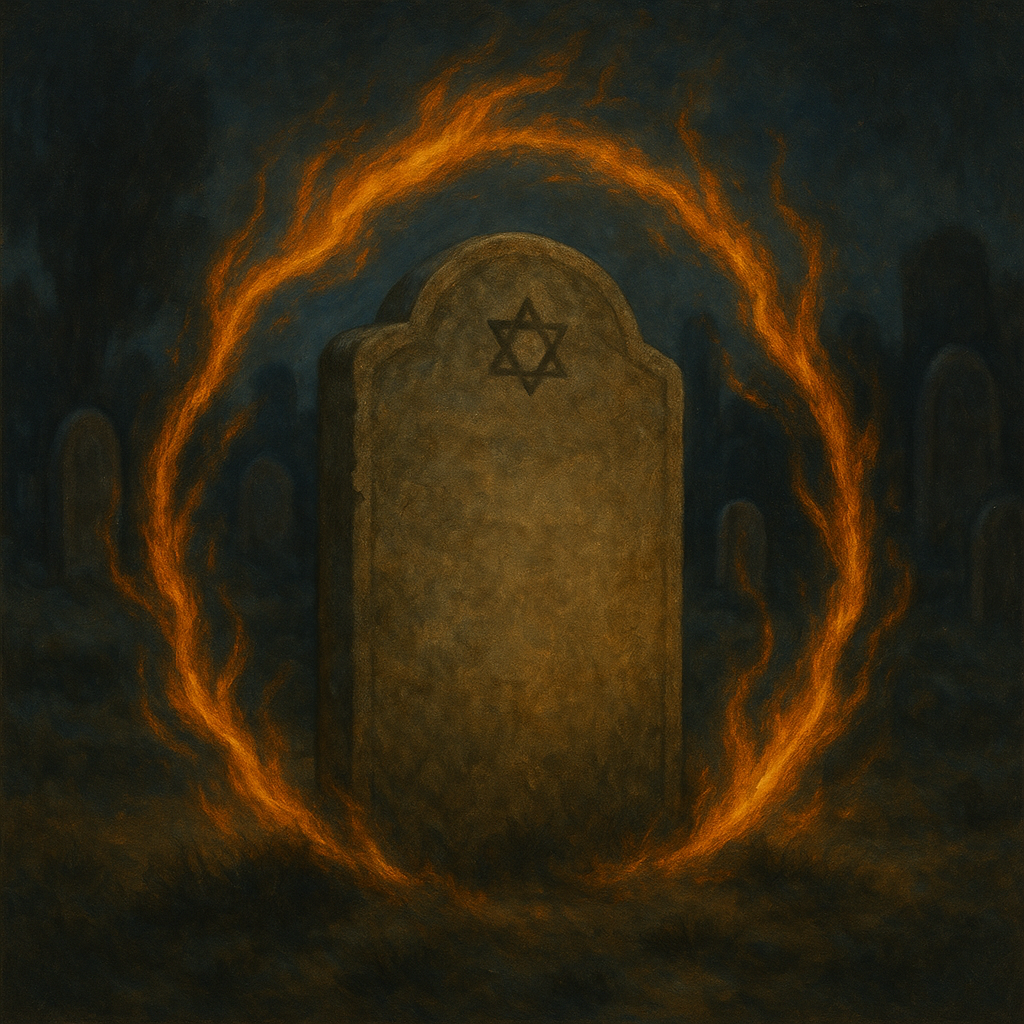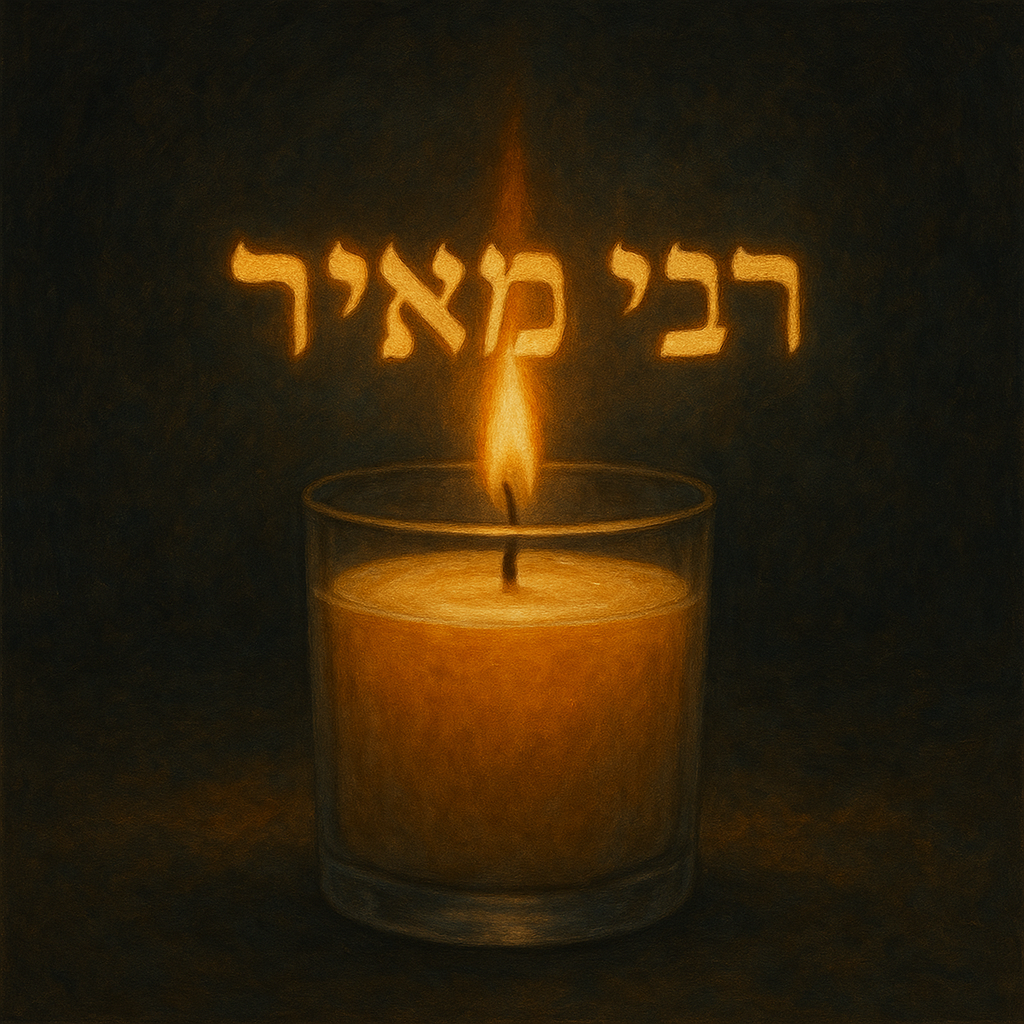Home » About Rabbi Meir » Rabbi meir biography » Teshuvah Meaning: Never Too Late to Repent – Acher’s Story
Teshuvah Meaning:
Understanding
Why It's Never Too Late to Repent
Learn how Acher’s deathbed return proves that no soul is beyond redemption
The concept of teshuvah has offered hope to the Jewish people for millennia, teaching that no soul is ever beyond redemption. One of the most powerful illustrations of this truth appears in the Talmud (Chagigah 15b), where we learn about Rabbi Meir Baal Haness and his fallen teacher, Elisha ben Avuyah. This teacher, who came to be known as “Acher” (the Other One), believed he had wandered too far from God to ever return. Yet Rabbi Meir never abandoned him, demonstrating through unwavering loyalty that even on one’s deathbed, the gates of return remain open.
The true meaning of teshuvah in Hebrew reveals why this hope is justified: the word derives from “shuv,” meaning “to return” or “come back”—not to be punished, but to come home to one’s authentic self. Through exploring the dramatic story of Acher’s return, understanding the four steps of teshuvah, and examining biblical examples of repentance that illuminate the teshuvah meaning, we discover why Judaism maintains it’s never too late to repent, even if one must repent on their deathbed.
What Does Teshuvah Mean in Jewish Theology?
The teshuvah meaning derives from the Hebrew root “shuv” (שׁ-ו-ב), which translates as “to return” or “to turn back.” This word origin reveals a fundamental distinction between Jewish and Western concepts of repentance. While the English term “repentance” carries connotations of punishment and penance, teshuvah frames spiritual repair as a journey homeward—a return to one’s essential nature rather than a departure from it.
This understanding rests on a central principle of Jewish theology: the concept of the “chelek Eloka mimaal” (a portion of God from above), described in the Tanya. The meaning of teshuvah in Hebrew thus encompasses not merely behavioral change but reconnection with this Divine essence that remains eternally pure. When a person transgresses, they create distance from their higher self, but they do not corrupt their fundamental nature. The soul’s innermost point—what Kabbalistic sources call the “nitzotz Eloki” (Divine spark)—remains untarnished regardless of one’s actions.
The mystics teach that every Jewish soul possesses this nitzotz Eloki, which the Zohar describes as being hewn from beneath the Divine Throne. No transgression can extinguish this holy flame; at most, sin can obscure it temporarily. Therefore, teshuvah represents not the creation of something new but the revelation of what was always present. This is why it’s never too late to repent—the essential connection between the soul and its Divine source remains intact, awaiting only our decision to return.
The Rabbi Meir and Acher Story: A Testament to Eternal Hope
The Talmud (Chagigah 15a-b) preserves one of Judaism’s most profound narratives about the possibility of return. Elisha ben Avuyah, once among the greatest Tannaim of his generation, experienced a spiritual crisis that led him to abandon Torah observance entirely. The Gemara relates that he witnessed injustices that shattered his faith—including seeing the tongue of the martyred Rabbi Chutzpit dragged through the dust. He declared himself “Acher” (the Other), believing he had severed his connection to the Jewish people permanently and placed himself beyond the reach of teshuvah meaning that forgiveness was no longer possible.
Despite Acher’s apostasy, Rabbi Meir maintained his relationship with his former teacher, demonstrating remarkable loyalty. The Talmud (Chagigah 15b) describes how Acher would ride his horse on Shabbos—a deliberate violation of Jewish law—while Rabbi Meir walked alongside, continuing to learn Torah from him. When they reached the techum (Sabbath boundary), Acher would warn: “Meir, return! I have measured by my horse’s steps that the Shabbos boundary extends to here.” Rabbi Meir would respond: “You too should return!” But Acher consistently refused, claiming he had heard a bas kol (Heavenly voice) proclaim: “Return, wayward children—except for Acher.”
The Jerusalem Talmud (Chagigah 2:1) records the climactic deathbed scene that demonstrates the ultimate power of teshuvah. When Acher fell mortally ill, Rabbi Meir visited him and asked, “Will you not do teshuvah?” Acher questioned whether repentance would even be accepted at such a late hour. Rabbi Meir cited Tehillim 90:3: “Tosheiv enosh ad daka”—”You turn man back until crushed,” teaching that until the final moment when the soul is crushed from the body, teshuvah remains possible. Upon hearing this, Acher wept and departed from this world. Rabbi Meir declared with joy, “It appears my master left this world in teshuvah,” understanding that even one who believed himself eternally rejected could ultimately return.
The Power of Never Abandoning Hope
When Acher believed he was permanently excluded from teshuvah, Rabbi Meir proved him wrong through the verse “Tosheiv enosh ad daka” (Tehillim 90:3)—teaching that Divine mercy extends until the soul’s final moment. If one who heard heavenly rejection could return, certainly every soul can. The nitzotz Eloki (Divine spark) never extinguishes; it only awaits our decision to return.
The Four Steps of Teshuvah According to the Rambam
1Step 1: Azivas HaCheit (Abandoning the Sin)
2Step 2: Charatah (Regret)
3Step 3: Vidui (Confession)
4Step 4: Kabbalah L'habah (Resolution for the Future)
Kabbalah L'habah (Resolution for the Future)
The Divine Assistance in Teshuvah
The Gemara (Shabbos 104a) teaches a fundamental principle: “Haba l’taheir mesay’in oso”—one who comes to purify himself receives Heavenly assistance. This promise reveals that once a person demonstrates sincere commitment to teshuvah through the four steps, they do not walk alone. The very act of turning toward the Divine activates what the Sages call “siyata d’Shmaya” (Heavenly help), transforming the difficult journey of return into a supported ascent.
The Talmud (Yoma 38b) elaborates: “Open for Me an opening like the eye of a needle, and I will open for you gates through which wagons and carriages can pass.” This teaches that even the smallest genuine step toward teshuvah generates disproportionate Divine assistance. When Acher finally wept on his deathbed, that single tear represented the needle’s eye through which infinite mercy could flow. The Zohar explains that each sincere attempt at return awakens tremendous compassion Above, creating a spiritual partnership where human effort meets Divine assistance.
Can One Truly Repent on Their Deathbed?
Jewish law unequivocally affirms the validity of deathbed repentance. The Shulchan Aruch (Yoreh De’ah 338:1) prescribes a specific deathbed confession (vidui) that requires no Rabbinic presence, emphasizing that teshuvah remains accessible until one’s final breath. Those preparing for end of life can find guidance in our comprehensive resources on deathbed prayers and Jewish customs for death, which detail the traditional vidui and spiritual preparations.
The Mishnah (Avos 2:10) records Rabbi Eliezer’s teaching: “Repent one day before your death.” When his students questioned how one could know their day of death, he responded that this uncertainty itself mandates daily teshuvah. Since no one ever knows when his last day will be, a person should repent every day. This teaching establishes perpetual spiritual readiness—understanding that the teshuvah meaning encompasses how each day presents both an opportunity and potentially our last chance for return. For those considering their spiritual legacy, our guide on writing a Jewish ethical will provides a framework for transmitting these values to future generations.
The Talmud (Avodah Zarah 17a) relates the remarkable account of Eliezer ben Durdaya, whose life epitomized transgression. Yet in his final moments, he achieved such profound teshuvah that a bas kol (Heavenly voice) proclaimed: “Rabbi Eliezer ben Durdaya is invited to the World to Come.” Upon hearing this, Rabbi Yehudah HaNasi wept, observing: “There are those who acquire their portion in the World to Come through years of toil, and there are those who acquire it in a single moment.” This teaching demonstrates that sincere deathbed confession in Judaism carries full spiritual validity, though it should never be relied upon as one’s primary strategy for teshuvah. Those planning ahead can explore our resources on advance directive wills to ensure their final moments align with Jewish values.
Stories of Repentance in the Bible: Eternal Examples of Return
The Tanach provides numerous repentance examples in the Bible that demonstrate the perpetual possibility of spiritual return, each offering unique insights into the nature of teshuvah.
The Transformation of Nineveh The Book of Yonah (Sefer Yonah), read in its entirety on Yom Kippur afternoon, presents perhaps the most dramatic collective teshuvah in scripture. When Yonah finally proclaimed Divine judgment upon Nineveh—”Od arbaim yom v’Nineveh nehepaches” (עוֹד אַרְבָּעִים יוֹם וְנִינְוֵה נֶהְפָּכֶת – In forty days, Nineveh shall be overturned – Yonah 3:4)—the entire city, from king to commoner, engaged in immediate and complete repentance. The verse states: “Vayar HaElokim es maaseihem ki shavu midarkam hara’ah” (וַיַּרְא הָאֱלֹקים אֶת־מַעֲשֵׂיהֶם כִּי־שָׁבוּ מִדַּרְכָּם הָרָעָה – And God saw their deeds, that they had returned from their evil way – Yonah 3:10), emphasizing that genuine action, not mere ritual, constitutes true teshuvah. This narrative teaches about second chances and demonstrates that even an entirely corrupt society can achieve collective return.
King David’s Paradigmatic Teshuvah Following the incident with Bas-Sheva, when the prophet Nosson confronted David with his parable, the king’s immediate response—”Chatasi l’Hashem” (חָטָאתִי לַה׳ – I have sinned before God)—became the model for genuine confession (Shmuel II 12:13). Tehillim 51, David’s prayer of repentance beginning “Chaneini Elokim k’chasdecha” (חָנֵּנִי אֱלֹקים כְּחַסְדֶּךָ – Have mercy upon me, O God, according to Your loving kindness), established the liturgical template for all subsequent prayers of teshuvah. Though David faced severe consequences for his actions, his teshuvah was accepted completely, demonstrating that sincere return repairs a spiritual breach.
The Remarkable Return of Menasheh Perhaps no biblical figure illustrates hope for the hopeless more powerfully than King Menasheh. According to the Talmud (Sanhedrin 103b), after twenty-two years of unprecedented evil—including idolatry, murder of innocents, and leading the nation astray—Menasheh was captured and imprisoned in his 22nd year of reign. Divrei HaYamim II (33:12-13) records: “U’k’harei lo, hispalel el Hashem Elokav, vayikana me’od milifnei Elokei avosav” (וּכְהָצֵר לוֹ חִלָּה אֶת־פְּנֵי ה׳ אֱלֹקָיו וַיִּכָּנַע מְאֹד מִלִּפְנֵי אֱלֹקֵי אֲבֹתָיו – In his distress, he entreated Hashem his God and humbled himself greatly before the God of his ancestors). God accepted his teshuvah and restored him to Jerusalem, where he spent his remaining thirty-three years—longer than his evil period—destroying the idolatrous altars he had erected and leading the nation in proper worship. If someone can return after two decades of wickedness and merit even more years of righteousness, the possibility of teshuvah truly never expires.
Transformation Through Return
The Gemara (Brachos 34b) teaches: “In the place where baalei teshuvah stand, even completely righteous individuals cannot stand.” This paradox reveals that falling can lead to ascending higher than before. When you overcome transgression and return to the root of the soul—the shoresh haneshamah—you acquire spiritual strength unavailable to those who never struggled. The Zohar explains that teshuvah motivated by love transforms even intentional sins into merits. Your greatest failures can become the foundation for your most profound connection to the Divine.
Finding Hope for the Hopeless: The Eternal Possibility of Return
Jewish mystical tradition, particularly as expressed in Chassidic thought, provides profound theological foundation for those who feel they are beyond redemption. The concept of returning to the root of the soul—the “shoresh haneshamah”—rests on the principle that the soul’s essential connection to its Divine source cannot be severed.
The Tanya (Chapter 24) explains that the Jewish soul possesses five levels: Nefesh, Ruach, Neshamah, Chayah, and Yechidah. While transgression may affect the lower levels, the Yechidah—the soul’s essence that is truly “one” with the Divine—remains perpetually pure and connected. This highest level serves as an unbreakable anchor, ensuring that return remains possible regardless of how far one has strayed.
Rebbe Nachman of Breslov famously declared: “If you believe you can destroy, believe you can repair” (Likutei Moharan II:112). He taught that despair itself represents the only true spiritual danger, for it denies the fundamental truth of the soul’s indestructibility. The Gemara (Kiddushin 30b) reinforces this concept, teaching that even when the Jewish people sin, they retain their essential identity as God’s children—”Bonim atem l’Hashem Elokeichem” (You are children to Hashem your God).
The Talmud (Berachos 34b) teaches: “In the place where baalei teshuvah (penitents) stand, even the completely righteous cannot stand.” This profound paradox highlights that those who have stumbled and returned can reach a spiritual height inaccessible to those who never faltered. The Zohar further explains that when teshuvah arises from love rather than fear, even deliberate sins are transformed into merits, serving as catalysts for an even deeper connection with the Divine. This teaching reveals the ultimate hope: that authentic teshuvah does not merely erase past failures but elevates them, turning struggles themselves into the very foundation for spiritual greatness once thought unimaginable
Supporting the Needs of Every Jew Through Rabbi Meir Baal Haness Charities
Since 1799, Rabbi Meir Baal Haness Charities has stood as a living testimony that no Jewish soul is ever forgotten. Just as Rabbi Meir refused to abandon Acher, even as he rode on Shabbos, we too remain by the side of our fellow Jews—lifting families from crushing poverty and ensuring no one feels cast aside.
When we show Hashem that His children are never neglected, He in turn shows us extraordinary compassion. The Rambam (Hilchos Teshuvah 3:4) teaches that charity possesses the power to overturn harsh decrees, while the Talmud (Bava Basra 10a) states that tzedakah brings redemption closer. Your support tells each struggling family that they matter, that their pain is seen, and that their soul is precious.
By extending your hand, you mirror Hashem’s boundless love and awaken blessing in your own life. Each act of tzedakah proclaims that Klal Yisrael is one family, where no one is abandoned. Rabbi Meir’s eternal promise—to intercede for those who remember the poor in his memory—makes your giving a source of both personal and communal redemption.
Consider establishing a lasting legacy through planned giving or charitable bequests to ensure this cycle of redemption continues. In the merit of Rabbi Meir Baal Haness, may your generosity bring teshuvah, refuah sheleimah, and overflowing bracha into your home.
Your Tzedakah Becomes Their Path Home Callout
Common Questions About Teshuvah Meaning and Jewish Repentance
Understanding the authentic teshuvah meaning raises important theological and practical questions. Here we address the most fundamental inquiries about this transformative concept.
Is it truly never too late to repent in Judaism?
Jewish law unequivocally affirms that teshuvah remains valid nad available until one’s final breath. The Rabbi Meir and Acher story (Chagigah 15b) provides definitive proof—even Acher, who believed a Heavenly voice had permanently excluded him, ultimately achieved teshuvah on his deathbed. This is possible because the nitzotz Eloki (Divine spark) within the soul never extinguishes, regardless of one’s actions. The Shulchan Aruch prescribes deathbed confession (vidui) specifically because return remains possible until the moment the soul departs. As Rabbi Meir taught Acher, citing Tehillim 90:3, God accepts return “ad daka”—until one’s final moment. The connection to the Divine is never severed; it merely awaits revelation.
What are the four steps of teshuvah according to the Rambam?
The Rambam (Hilchos Teshuvah 2:2-3) delineates four essential steps:
(1) Azivas HaCheit—immediately abandoning the transgression, as one cannot repair while continuing to damage.
(2) Charatah—genuine regret that recognizes the betrayal of one’s Divine nature, not destructive guilt but constructive recognition.
(3) Vidui—verbal confession using the formula “Ana Hashem, chatasi, avisi, pashati” followed by specific acknowledgment of the transgression.
(4) Kabbalah L’habah—sincere resolution never to repeat the sin. The Rambam defines complete teshuvah (teshuvah gemurah) as occurring when one faces the same temptation and refrains due to genuine transformation, not fear or inability.
How does the teshuvah meaning differ from Western concepts of repentance?
The teshuvah meaning in Hebrew fundamentally differs from “repentance.” Teshuvah derives from “shuv”—to return or come back—implying homecoming rather than punishment. While repentance emphasizes guilt and penance, teshuvah teaches that the soul possesses an indestructible Divine essence, the ‘chelek Eloka mimaal’ described in the Tanya. Sin merely obscures this pure essence temporarily. Teshuvah means removing the covering to reveal the neshamah that was always pure. This transforms the process from self-flagellation into joyous return to one’s authentic identity. Learn more about prayer formulas that facilitate this return.
Are there authentic examples of last-minute repentance succeeding?
The Talmud preserves several accounts of successful deathbed teshuvah. Beyond the Rabbi Meir and Acher story, the Gemara (Avodah Zarah 17a) relates how sinner Eliezer ben Durdaya achieved such profound repentance in his final moments that Heaven proclaimed him as “Rabbi Eliezer ben Durdaya” and welcomed him to Olam Haba. King Menasheh (Divrei HaYamim II 33) repented after thirty-three years of evil and was forgiven. These stories of repentance in the Bible and Talmud demonstrate that sincere teshuvah—even if one must literally repent one day before death—carries full validity.
How can one maintain hope when feeling spiritually lost?
The feeling of being “beyond redemption” contradicts fundamental Jewish theology. The soul’s connection to its Divine source—the shoresh haneshamah—cannot be severed. The Gemara (Kiddushin 30b) teaches that Jews remain God’s children even when they sin. Rebbe Nachman’s teaching “If you believe you can destroy, believe you can repair” (Likutei Moharan II:112) emphasizes that the capacity for return equals the capacity for damage. Even the smallest prayer or desire to return initiates the journey home. There’s always hope for the hopeless because the Yechidah, the soul’s highest level, maintains eternal connection to the Divine.

 The Original Lost Object Story: How It All Began
The Original Lost Object Story: How It All Began Elisha’s Grave Fire: The Aftermath of Acher’s Death
Elisha’s Grave Fire: The Aftermath of Acher’s Death Promise Power: How Rabbi Meir’s Vows Work
Promise Power: How Rabbi Meir’s Vows Work
 Divine Light in Dark Times: Spiritual Remedies That Work
Divine Light in Dark Times: Spiritual Remedies That Work
